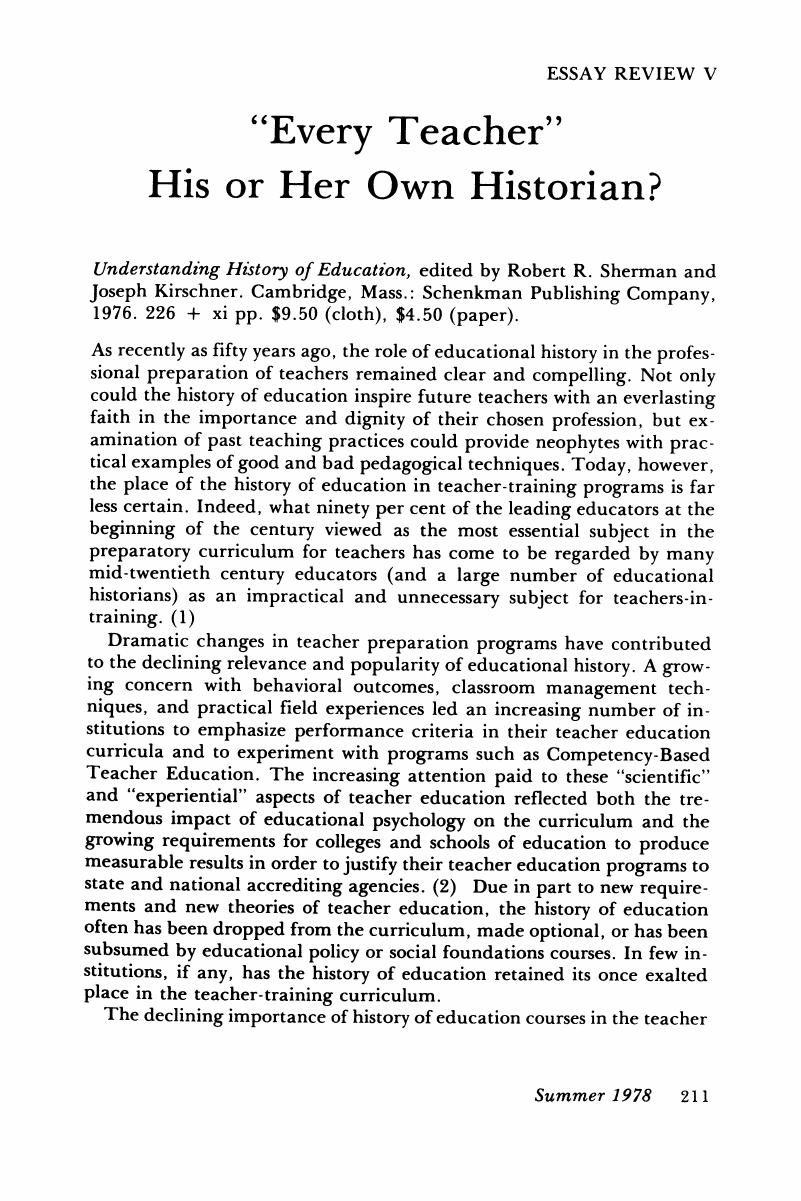No CrossRef data available.
Article contents
“Every Teacher” His or Her Own Historian?
Published online by Cambridge University Press: 24 February 2017
Abstract

- Type
- Essay Reviews
- Information
- Copyright
- Copyright © 1977 by New York University
References
Notes
1. Luckey, G. W. A., The Professional Training of Secondary Teachers In the United States (New York, 1903), p. 177. Comparable figures for today are not available; however, in a 1969 survey, fifty-two curriculum professors and fifty-two curriculum practitioners were asked to assess the degree of importance that should be given to thirty-two areas of professional education in doctoral programs for curriculum practitioners. Only 2.5 per cent of the professors and 11.5 per cent of the practitioners felt the history of education was of “great importance.” Similarly, 47.5 per cent of the professors and 40.4 per cent of the practitioners felt that history of education was “relatively unimportant.” Wood, Bob G. and Wood, Fred H., “Areas of Emphasis In Doctoral Programs for Curriculum Practitioners Since 1969,” Educational Leadership, 35 (February, 1978): 396.Google Scholar
2. Presentations at the 1978 Annual Meeting of the American Association of Colleges For Teacher Education (AACTE), held in Chicago, February 21–24, illustrated the almost exclusive attention paid to the measurable and behavioral aspects of teacher preparation. The sessions were grouped under the following eight sub-themes: “[Teacher] Selection and Retention,” “Teacher Education In Measurable Terms,” “Student Teaching/Clinical Experiences,” “Special Needs In Regular Classrooms,” “Diagnostic-Prescriptive Teaching,” “Follow-Up Studies,” “Teacher Behavior and Student Learning,” and “Evaluation of Teaching and Careers.” The program made no mention of the normative or critical components of teacher education programs.Google Scholar
3. Bestor, Arthur, Educational Wastelands (Urbana, 1953); Bailyn, Bernard, Education In The Forming of American Society (New York, 1960); Conant, James B., The Education of American Teachers (New York, 1963); Cremin, Lawrence, The Wonderful World Of Ellwood Patterson Cubberley (New York, 1965).Google Scholar
4. Bailyn, , Education, p. 14.Google Scholar
5. To be sure, prospective teachers have not been totally ignored by educational historians in the past two decades. Among others, Butts, R. Freeman continues to direct his scholarly attention to traditional professional concerns of the educational establishment. See, for example, “Public Education and Political Community,” History of Education Quarterly, 14 (Summer, 1974): 165–183. Urban, Wayne J. addresses the professional interests of teachers in his on-going research on the origins of teacher unionization. See “Organized Teachers and Educational Reform During The Progressive Era: 1890–1920,” History of Education Quarterly, 16 (Spring, 1976): 35–52. Finally, and somewhat ironically given his close association with the broad cultural approach to educational history, Lawrence A. Cremin continues to make his research findings available and relevant to teacher audiences. See Public Education (New York, 1976), and “The Education of the Educating Professions,” 19th Annual Lecture, Charles W. Hunt, Annual Meeting of The American Association of Colleges for Teacher Education, Chicago, February, 1978.Google Scholar


